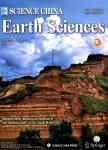Size variation of the end Permian conodont Neogondolella at Meishan Section,Changxing,Zhejiang and its significance
Size variation of the end Permian conodont Neogondolella at Meishan Section,Changxing,Zhejiang and its significance作者机构:Faculty of Earth Sciences China University of Geosciences Wuhan 430074 China Faculty of Earth Sciences China University of Geosciences Wuhan 430074 China Faculty of Earth Sciences China University of Geosciences Wuhan 430074 China Faculty of Earth Sciences China University of Geosciences Wuhan 430074 China
出 版 物:《Science China Earth Sciences》 (中国科学(地球科学英文版))
年 卷 期:2006年第49卷第4期
页 面:337-347页
核心收录:
学科分类:07[理学] 08[工学] 0708[理学-地球物理学] 0704[理学-天文学]
基 金:supported by the National Natural Science Foundation of China(Grant No.40232025) the GeoTurn Group of China University of Geosciences
主 题:Meishan Section, end Permian, conodont, Neogondolella, size reduction.
摘 要:This study is based on both a generic and species level investigation of the individual size of the latest Permian conodont Neogondolella Pa elements collected from Meishan Section A, Changxing, Zhejiang Province. In this study, an obvious size reduction of Neogondolella Pa elements within bed 24e of the upper Changxing Limestone is recognized. The size variation of the Neogon- dolella occurs simultaneously with some important events including the negative shift of δ 13C, change in the ratio of the abundance of cyanobacterial biomarkers versus that of other general bacterial biomarkers and the shallowing of the sea water. Through the investigation of the paleoenvironmental changes and the analysis of the paleoecology of the conodont genus Neogondolella, the authors propose that the major factors for the size reduction of species of the conodont genus Neogondolella are food shortages caused by the mass extinction, the shallowing of the sea water as well as the in- crease in opacity of the sea water during the end Permian. The same phenomenon of Neogondolella size reduction is also observed in preliminary research from the same horizon at Shangsi Section, Sichuan Province. All the evidence suggests that there was a mass extinction that occurred at the horizon of bed 24e, and the evidence supports the viewpoint of a multi-phase mass extinction during the Permian and Triassic transition in South China.



